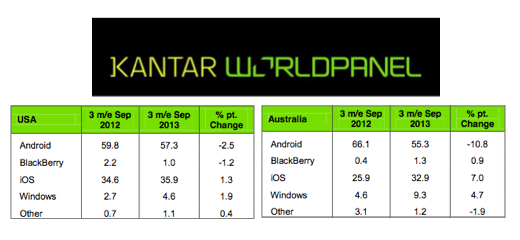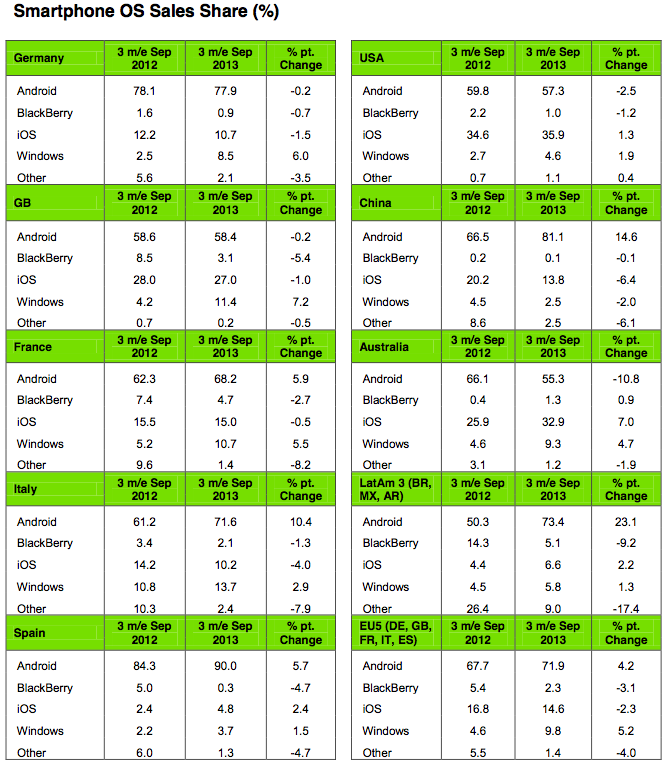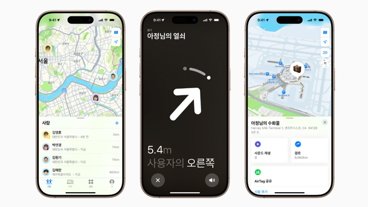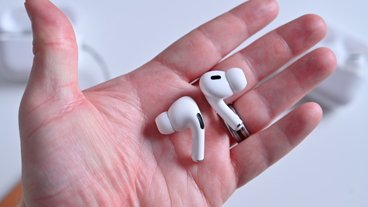Apple's share of smartphone sales through the September quarter nudged up 1.3 percentage points in the U.S., 2.2 points in Latin America, and a dramatic 7 points in Australia, while slipping 6.4 points in China and losing 2.3 points across Western Europe.
The shifts, detailed in a report by Kantar Worldpanel, illustrate differences across territorial markets globally.
Kantar's U.S. figures also harmonize with the direction of numbers from comScore last month, which similarly showed Apple taking American phone share at the expense of Android and BlackBerry this summer.
Three growth regions for iOS
In the U.S., Kantar reported that Android fell 2.5 points over the year ago September quarter to reach 57.3 percent of sales, while Apple inched up to claim 35.9 percent of sales on the cusp of the release of new iPhone 5c and 5s models.
Nokia's Lumia running Windows Phone gained 1.9 percentage points to claim 4.6 percent of U.S. sales, while BlackBerry fell 1.2 points to end up with just 1 percent of the quarter's sales."The full impact of the new iPhones will be seen at Christmas when iOS is expected to bounce back strongly in Britain, the US and Australia" - Kantar
In Australia, Android fell even more dramatically, losing 10.8 points over the previous year to end up with 55.3 percent of sales. Apple was up 7 points, reaching 32.9 percent of sales, while Nokia claimed 9.3 percent and Blackberry 1.3 percent.
In Brazil, Argentina and Mexico, Kantar reports that iOS sales are up 2.2 percent YoY in the September quarter, but account for just 6.6 percent of all sales. Android share is up dramatically, taking 23.1 percentage points.
The big loser in that region is BlackBerry, down 9.2 percentage points, falling from 14.3 percent to just 5.1 percent of new sales in one year.
Kantar analyst Dominic Sunnebo noted in the report, "August is traditionally a quiet month for Apple as consumers wait for the release of new models, and strong sales of the iPhone 5S and 5C at the end of September did not manage to make up for the lull. The full impact of the new iPhones will be seen at Christmas when iOS is expected to bounce back strongly in Britain, the US and Australia."
iOS phone share falls in China
Dramatic increases in generic Android phones were also apparent in China, where the OS now accounts for 81.1 percent of sales, albeit not in a way that really benefits Google. All other phone platforms saw a drop in overall sales share.
Apple's iOS reported a loss of 6.4 percent of all phone set sales in China, despite the company's YoY sales growth of 6 percent in the region. Kantar noted that Apple's sales are "expected to strengthen at Christmas."
Apple reported revenues of $5.733 billion for China in the quarter, a sequential increase of 24 percent, and revenues of $27 billion for greater China in the fiscal year, an increase of 14 percent.
iOS in Western Europe
In Western Europe (Germany, Great Britain, France, Italy and Spain), Kantar reported iOS losing 2.3 points of phone sales share in the quarter. Apple was actually up 2.4 percentage points in Spain, which has the highest percentage of Android users, now at 90 percent.
Apple was down 1 percentage point in Great Britain, half a percentage point in France and a point and a half in Germany. Apple lost the most market share ground in Italy, where it now has a reported 10.2 percent share of the phone market, lower than Nokia's 13.7 percent share, the feature of the report emphasized by Kantar and repeated by much of the media.
Terribly confused as to why people think Nokia's sub 150 Euro Windows Phone outselling the 600 Euro iPhone is some sort of sign of success.
— Stefan Constantine (@WhatTheBit) November 4, 2013
Kantar's numbers reflect sales occurring in Apple's fourth fiscal quarter, historically one of the lowest quarters for the company as it gears up for its important Q1 holiday season. The numbers also only reflect smartphone sales, ignoring the impact of iPad sales, which have been particularly important in growing Apple's sales in China and expanding the influence of iOS in education and in the enterprise.
 Daniel Eran Dilger
Daniel Eran Dilger





-xl-m.jpg)


-m.jpg)






 Thomas Sibilly
Thomas Sibilly
 Wesley Hilliard
Wesley Hilliard
 Christine McKee
Christine McKee
 Amber Neely
Amber Neely
 William Gallagher
William Gallagher
 Malcolm Owen
Malcolm Owen

 Mike Wuerthele
Mike Wuerthele







17 Comments
And what is it after iphone 5s and 5c ?
Wow this is a great look at Apple's declining marketshare in China in the recent past before Apple launched the most successful smart phones in the history of smart phones, the 5S and 5C which sold 9 million in a weekend alone.
I wonder why Japan market shares figures are not showing. Many reports are indicating rapid iPhone growth in Japan at the moment. PS: Daniel, thank you for your thorough analysis and always-fresh insights!
Yeah, but... but... but Wall Street will say that because China is the biggest emerging market, Apple has slipped quite a bit there (-6.4%), so Apple must be downgraded and declared doomed. What I'm really surprised about is that Apple is gaining a nice amount in Australia which I'd always thought was a pro-Apple country. Good for Apple. A love to hear when Apple makes some gains against Android because every little bit helps. Android still has 80% global smartphone market share so it hardly makes a dent in the big scheme of things. Android users in Spain at 90% is just incredible. That economy must really be hurting. I'll bet no one in Spain can afford an iPhone or anything Apple. I guess that's why Apple is so doomed.
There are many aspects to these stories, enough so that can not just be explained by simple market share percentages. It is conceivable, that Apple, or any other company for that matter, can sell more devices than the previous year and still loose market share. Another stat one should look at, if he is to come to some logical conclusion about the market, is to compare like models. For example, how many Samsung Galaxy S3's and S4's did they sell compared to Apple's iPhone 4S and 5 sales. In other words compare each company's flagship models from the last two years with each other and not lump in the entire Samsung range and LG range and the Nokia range etc. vs. Apple's two or three very top model offerings. This can explain many worldwide usage statistics we are seeing, where Apple, despite their so called declining market share, still have much better than average usage statistics. The other thing to take into account is where does Apple compete in? It is definitely not being carried by China Mobile yet and it has practically no entry into the Indian market and we haven't even begun to talk about Africa or South America yet where many Android variants are already available in those markets. This story is far more complicated than any quick blog can explain, or even have the capacity to do so.